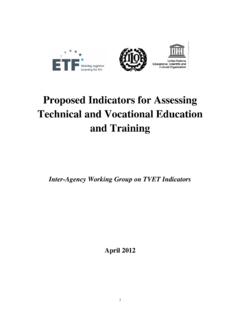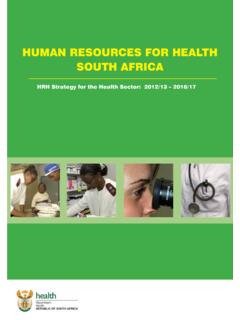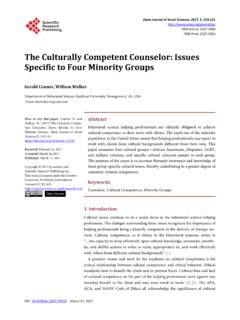Transcription of Guide to Policy Analysis - Europa
1 Guide to Policy Analysis2 Guide to Policy AnalysisCONTENTS1. INTRODUCTION 32. A CONCEPTUAL FRAMEWORK FOR Policy Analysis Key notions The anaytical process Connecting the dots: guidance for good-quality Analysis 203. AN IMPLEMENTATION FRAMEWORK FOR Policy Analysis Reality check and consultations Evidence and common sense A word on involvement and ownership Analysis in real-life conditions: typical challenges 324. INSTEAD OF CONCLUSION 345. THE PRACTICE OF Policy Analysis : EXAMPLES FROM THE WORK OF PARTNER COUNTRIES WITH THE ETF Analysis in support of setting the agenda: the ETF s PRIME assessment of VET policies for female employability in Jordan 38 Analysis in support of Policy formulation: foresight through the ETF FRAME project for South Eastern Europe and Turkey Analysis in support of Policy implementation: assessment of MTDs under the Riga Conclusions in Serbia Analysis in support of monitoring of progress and Policy evaluation.
2 The Torino Process in Ukraine 46 ACRONYMS 49 REFERENCES 50 PDF ISBN 978-92-9157-688-3 Guide prepared by Mihaylo Milovanovitch, ETF expert. European Training Foundation, 2018 Reproduction is authorised provided the source is to Policy AnalysisWhat is this Guide about?This Guide summarises the experience of the European Training Foundation (ETF) in working with Policy Analysis , and provides operational guidance to its partner countries on Policy Analysis techniques and their use at different stages of the Policy cycle. It describes a theory and practice of Policy Analysis that is rooted in the work of the ETF. The Guide will be used to develop a range of learning opportunities for ETF Guide is structured in two parts.
3 The first part (Sections 1 4) outlines the key notions and conceptual framework of Policy Analysis , and the basics of its application. The second part (Section 5) describes selected ETF projects and their methodology to demonstrate how Policy Analysis can be applied in support of decision making at key stages of the Policy cycle: agenda setting (problem identification); Policy formulation; Policy implementation; and Policy is this Guide necessary?To promote the use of Policy Analysis in partner countries in support of Policy making and learningThe Guide is intended to address requests for help by professionals in partner countries (analysts, practitioners in vocational education and training (VET), administrators, etc.)
4 Who are responsible for informing decisions at different stages of the Policy cycle through Policy Analysis . The need for support emerges because of challenges associated with the task of informing Policy making in a reliable and timely manner. Improvement in the area of VET in ETF partner countries is increasingly dominated by complex evidence and developments, the interpretation of which requires knowledge, skill, experience and conceptual clarity. In addition, the stakes associated with the analytical findings can be high, for instance when they are formulated in support of difficult decisions, in uncertain environments (ETF, 2013a), or in response to socioeconomic challenges, such as youth unemployment, migration , or resource Guide cannot resolve the complexities and trade-offs inherent in Policy making, but it can help those involved to make the best of the available evidence and Policy options, and professionalise (ETF, 2013a) the analytical process.
5 The ultimate goal is to strengthen the ability of VET stakeholders to carry out systematic assessments of Policy options and implementation (ETF, 2016b) and move them towards a routine use of Policy Analysis in decision strengthen the quality of analytical contributions by partner countries participating in ETF activitiesThe activities of the ETF are also influenced by these developments. More and more of these activities encourage partner countries to shift the focus of their involvement away from mere validation of findings formulated by external experts and towards self-directed, independent production of content and authoring of project deliverables.
6 Examples of such projects include FRAME and PRIME, the ex-ante assessments of Riga medium-term deliverables (MTDs) in countries of South Eastern Europe, and the 2016 round of the Torino Process. Common to all these projects is that they rely on in-depth thematic consultations between national participants in VET and on analytical results prepared at national level by entities in charge of VET Guide summarises key assumptions, analytical steps and quality standards of Policy Analysis and offers them as a point of reference to partner countries that wish (or are required) to provide analytical input in the course of their cooperation with the ETF.
7 5 Guide to Policy AnalysisThe purpose is to offer countries a clear path towards contributions that are reliable, of good quality, and ready for use. For the ETF, the benefit of this effort is the opening of a reliable channel for the proper contextualisation of priorities and analytical findings in accordance with the preferences, traditions and priorities of is this Guide for? Policy Analysis delivers knowledge, which has its producers, beneficiaries and contributors. These can be broadly divided into Policy makers (beneficiaries), researchers and analysts (knowledge producers) and stakeholders such as education practitioners, parents and local administrations (European Commission/EACEA/Eurydice, 2017), who can be beneficiaries, but also contributors of information and insights for the Analysis .
8 In the realm of Policy making and implementation, these roles can (and often do) overlap. Policy makers might be deeply involved and might steer or manage the production of analytical knowledge. Analysts might influence Policy decisions in ways that makes them the de-facto decision makers. Stakeholders might be a source of vital information for the Analysis , or they might have commissioned it themselves and also directly participate in the formulation and validation of its Guide serves the capacity-building needs of them all, albeit to a varying extent. Its primary audience is the knowledge producers those in charge of delivering analytical evidence and insight into what has been done and achieved, what could be done next, and how it could be done better.
9 The Guide provides them with suggestions on how to make the Analysis better and more reliable. This information could also be relevant for the beneficiaries of Analysis , to the extent that they are also the ones responsible for the quality of analytical deliverables. Finally, stakeholders might use this Guide as a point of reference on the modalities of involvement in the analytical CONCEPTUAL FRAMEWORK FOR Policy KEY NOTIONSIn its modern form, Policy Analysis emerged in the 1960s as a product of economic and reconstruction planning for Europe after World War II (Walt and Gilson, 1994), but its roots date back to the 1940s or even earlier.
10 Initially conceived as a way to improve health policies and deal with water resource problems, it has been extended to a number of other public sectors, including education and training (Healey, 2011).After years of application in the public domain, Policy Analysis has evolved into a diversified and heterogeneous field with numerous analytical perspectives and frameworks (ETF, 2013a). Describing them in detail is beyond the scope of this Guide . Instead, the following sub-sections offer a compilation of notions that are fundamental enough to apply across the board of analytical approaches, and are key to the use of the Guide . The compilation might also provide useful guidance for those readers who wish to follow up and gain a deeper knowledge by working on their own with the literature on Policy Analysis .




